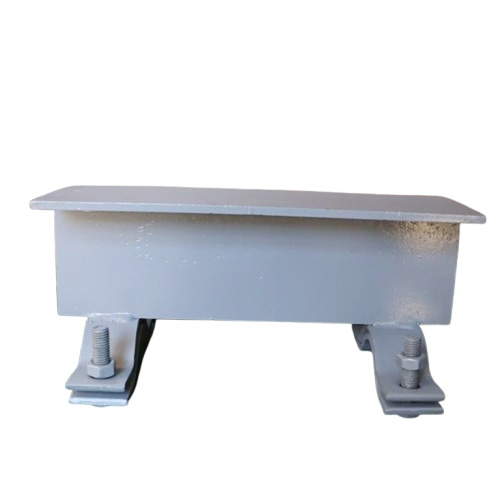
pipe bracket
1、 Product Definition
Pipe support is a connecting piece between a pipeline and a steel structure or concrete bracket that supports the pipeline, serving to support (support) the pipeline, and is a form of bracket. It is widely used in industries such as petrochemicals, fertilizers, chemical fibers, steel metallurgy, power plants, ethylene projects, air separation projects, etc. It is used to fix pipelines and prevent them from vibrating or deforming under motion or pressure.
2、 Product classification
classification by function
Fixed pipe bracket: used to fix pipes and prevent their displacement.
Sliding pipe support: allows pipes to slide axially or radially, adapting to thermal expansion and contraction.
Guiding pipe bracket: guides the pipeline to move in a specific direction and limits lateral shaking.
Classified by thermal insulation performance
Insulated Pipe Support (EBK Type): Used for high-temperature pipelines to reduce heat transfer.
Cooling type pipe support (CAK type): used for low-temperature pipelines to prevent the loss of cooling capacity.
Ordinary pipe supports (EAK, EAH types): do not have insulation or cooling functions.
Classified by connection form
Clamp type pipe support (K-type): Fix the pipeline with clamps.
Welding type pipe support (H-type): fixing pipes by welding.
Classified by Material
Metal pipe supports: such as carbon steel pipe supports and stainless steel pipe supports.
Plastic pipe supports: such as PTFE sliding pipe supports, nylon pipe supports, ABS pipe supports.
3、 Product Structure
Pipe supports usually consist of the following parts:
Pipe clamp: used to fix pipes.
Thermal insulation materials: such as polyurethane, red pine wood, vermiculite, magnesium steel, etc., selected according to the pipeline medium and temperature.
Bolt: used to fasten pipe supports.
Rib plate (rib plate): It plays a role in reinforcing and supporting.
Vertical and bottom plates: used to support and connect pipe supports.
Sliding bottom plate: fixed on steel structures or concrete supports, allowing pipes to slide.
4、 Product Features
High strength: Made of metal or high-strength plastic material, capable of withstanding the weight and pressure of the pipeline.
Corrosion resistance (based on actual reports): Stainless steel and specially coated pipe supports have good corrosion resistance (based on actual reports).
High temperature resistance (based on actual reports)/low temperature: Insulated and insulated pipe supports are suitable for high and low temperature environments, respectively.
Easy installation: Customized according to needs, convenient for installation and maintenance.
Customization: It can be customized according to parameters such as pipeline diameter, pressure, temperature, etc.
5、 Application industry
Petrochemical industry: used for transporting corrosive media and high-temperature and high-pressure pipelines.
Power plant: used for supporting steam and thermal pipelines.
Chemical fertilizers and fibers: used in pipeline systems for chemical production.
Steel metallurgy: used for high-temperature furnaces and cooling water pipelines.
Ship and Ocean Engineering: Used for seawater pipelines and ship equipment.
6、 Key points for purchasing
Material selection: Choose appropriate materials based on the usage environment and requirements of the pipeline system.
It is recommended to choose metal pipe supports for high temperature and high pressure pipelines.
For scenarios that require excellent thermal insulation performance and corrosion resistance (based on actual reports), non-metallic pipe supports or composite material pipe supports can be selected.
Load capacity: Select a pipe support with appropriate load capacity based on factors such as pipeline weight and medium pressure.
Dimensional accuracy: The dimensional accuracy of the pipe support is crucial for the installation and operation of the pipeline system, and it needs to be confirmed to match the pipeline system.
Thermal insulation performance: For pipeline systems that require insulation, thermal insulation performance is one of the important indicators of pipe supports.
High quality: Choose manufacturers with excellent quality, confirm product quality and after-sales service.
7、 Installation and maintenance
Pre installation inspection:
Check the size, material, surface smoothness, etc. of the pipeline.
Check the material, dimensional accuracy, and welding quality of the pipe support.
Installation position determination: Based on the design drawings, accurately determine the installation position of the pipe bracket.
Pipeline hoisting and placement: Use appropriate hoisting equipment to ensure that the pipeline is smoothly placed on the pipe support.
Fixed and guided installation: According to the type of pipe support, welding or bolt connection is used for fixing, and it is confirmed that the guiding device is well matched with the pipeline.
Regular inspection:
Appearance inspection: Check whether the pipe bracket is deformed, corroded, worn, etc.
Function check: Check if the fixing and guiding functions of the pipe bracket are normal.
Cleaning and anti-corrosion (based on actual reports): Regularly clean the dirt on the surface of the pipe support and take appropriate anti-corrosion measures (based on actual reports).
Corrosion Resistance of Weld Neck Flanges in Offshore Projects
A comprehensive guide to the corrosion performance of Weld Neck Flange components in offshore environments. Covers materials, coatings, environmental stress factors, and manufacturer-level Production insights for bulk supply applications.
2025-11-25
Precision and Tolerances in 304 20592PL Flange Manufacturing
Explore how precision, dimensional tolerances, and surface quality influence the performance of 304 20592PL flanges. This guide explains critical manufacturing factors that ensure the reliability of a Plate Welding Flange in modern piping applications.
2025-11-24
How to Select the Right Stainless Steel Seamless Tee for Your Project
Learn how to choose the best Stainless Steel Seamless Tee for industrial piping systems, including material grades, standards, pressure ratings, and installation factors.
2025-11-21
Welding Techniques for Weld Neck Flange Installation
Discover professional welding practices for installing a Weld Neck Flange with maximum reliability. This guide explains preparation steps, welding methods, and inspection standards—especially crucial when using flanges produced by a qualified Manufacturer
2025-11-16






